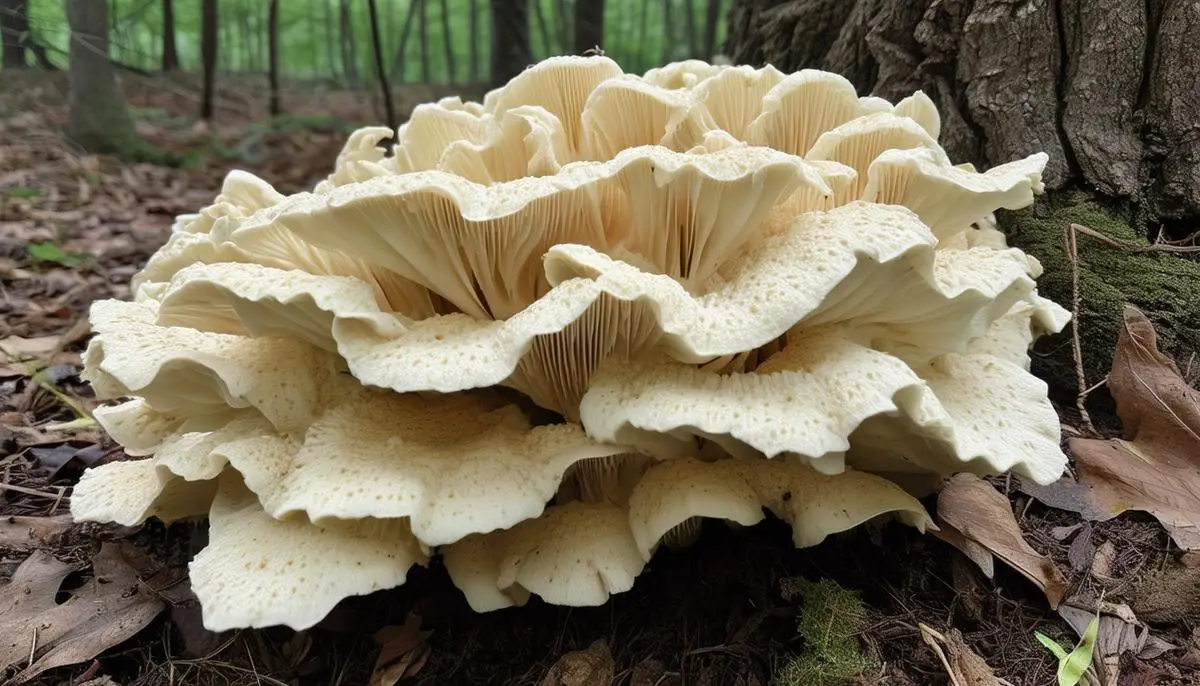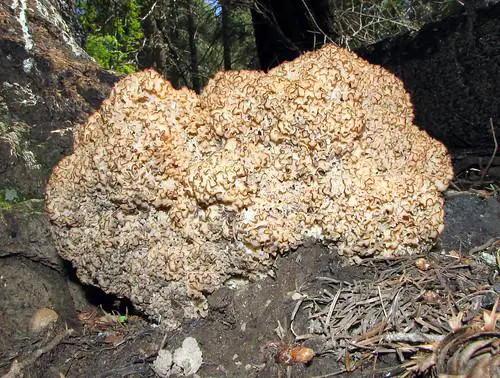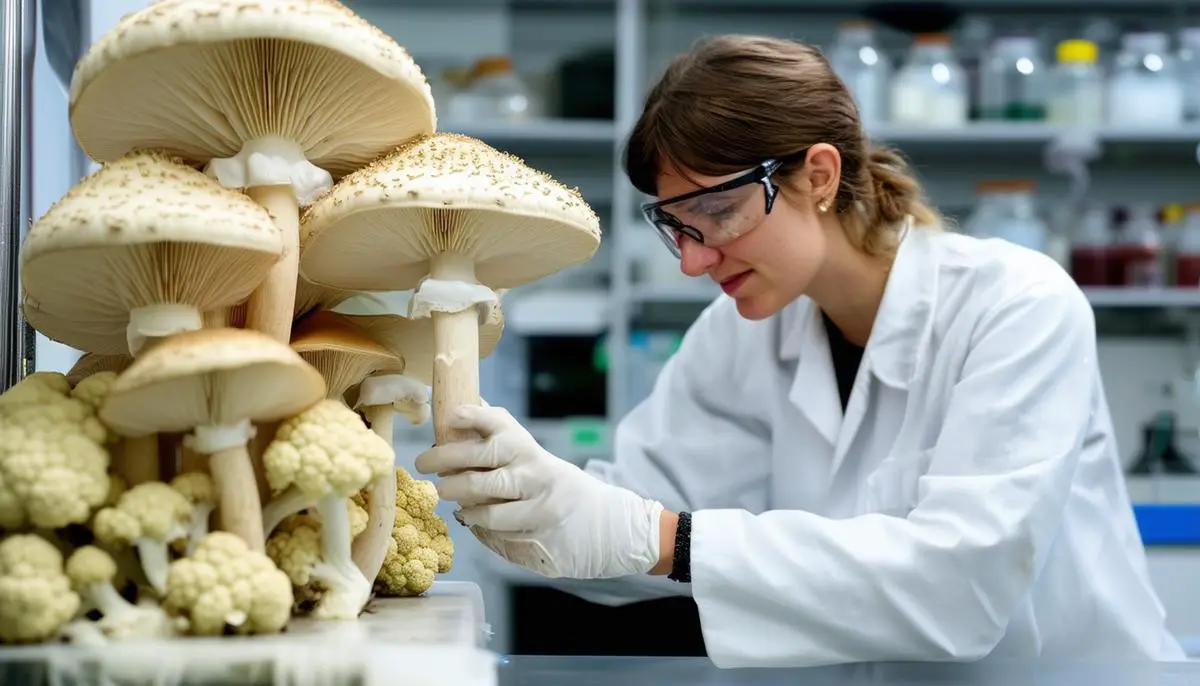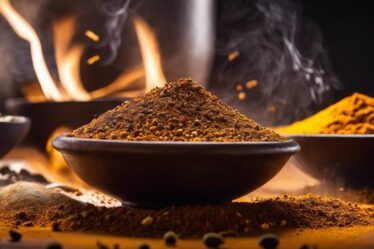
Identification and Habitat
The Eastern Cauliflower Mushroom, scientifically known as Sparassis spathulata, is an intriguing species that exhibits several distinctive features aiding in its identification. Typically, this mushroom appears as large, stalkless, whitish-yellow rosettes with flattened, wavy, ribbon-like folds. Such a peculiar formation often resembles a cluster of leafy, thin lettuce or crumpled fabric spread at the base of hardwood trees, predominantly oak stumps. They usually grow as solitaires and can reach a sizable diameter of 6 to 12 inches and heights ranging from 6 to 10 inches, making them quite noticeable on the forest floor.
One of the vital phases of identification is the timing; these mushrooms often emerge between July and October and thrive during or just after periods of rainfall. Their youthful bodies are flexible, gradually becoming tougher with age—a noteworthy point for those collecting for culinary use, as the tender, young specimens are the choicest.
S. spathulata's spore prints, which are instrumental for mushroom identification, produce a white color. Examining spores under magnification reveals they are oval, smooth, and colorless, busy whispering tales of their genetic blueprint.
Moving onto the habitat, Eastern Cauliflower Mushrooms prefer company on damp soil supplied plentifully by recent rains. These mushrooms are known to flirt with forest decomposers and primarily establish themselves at the base of hardwoods but are accommodating enough to settle even in mixed-hardwood forests occasionally.
Optimally, they spring from places pulsating with life yet bound by decay, often luxuriating at the roots of decayed oak. Their occurrence can be sporadic in nature—lavishly abundant during mesic summers following the script of a bold wet season while turning coy and rare when the summer denies its moist pledges.
For exact identification during your woodlands gait, remember they often reappear annually at the same spots. Experts and enthusiasts know this; the secret tip is to mark their whereabouts mentally or in a global wandering app.

Culinary Uses
Celebrated for its subtle flavors and flexible culinary utility, the Eastern Cauliflower Mushroom imparts a mild, nutty essence, accompanied by a texture that can range from delightfully crunchy when young to more robust and chewy as it ages. This versatility ensures that Sparassis spathulata can complement a myriad of dishes, both simple home comforts and high cuisine creations.
In the ambit of gourmet cooking, chefs akin to artisans wield the Eastern Cauliflower Mushroom with grace, showcasing its potential in sophisticated dishes. A tender young cauliflower can be sautéed lightly in a delicacy of garlic butter, allowing the mushroom's own flavors to be the hero of the plate, supported subtly by the aroma of fresh herbs—perhaps a whisper of thyme or a hint of tarragon. In another elevated preparation, one might find it as a star in creamy risottos, where its textures play delightfully against the al dente grains of Arborio rice, with a generous shower of Parmigiano-Reggiano melding all components into a symphony of flavors.
Daring culinary enthusiasts have even extended their creative use to include this mushroom in vegan or vegetarian recipes, substituting it for meat in rich stews or as a base for vegan patties, where its meaty body complements the crunch of fresh vegetables.
For those inclined toward the traditional or nostalgic, the Eastern Cauliflower Mushroom finds a place in old-world recipes such as mushroom soups and stroganoffs. Here, its ability to soak up surrounding flavors enriches every spoonful. Long simmers in stocks or broths coax out its earthy tones, making it an ideal addition to hearty autumn and winter meals that promise both warmth and satisfaction.
Consider the luxurious folds of the rosette leading in more elaborative presentations like tempura, where its curled edges catch light, airy batter just right, leaving an exquisite crunchy exterior with a comfortably cushy heart—perfect for dipping into a softly tangy ponzu sauce.
Through each culinary exploration, the Eastern Cauliflower Mushroom remains a testament to the lavish gifts of nature—subtly asserting its presence in dishes that span cultures and culinary styles. Whether you find yourself in an apron at home, or wielding chef's knives behind the burnished counters of gourmet restaurants, keeping an eye out for this unique fungus can turn your ordinary recipe into an extraordinary exploration of flavor and texture, celebrating the forest's bounty in each bite.

Medicinal Properties and Research
While principally celebrated for its culinary attributes, the Eastern Cauliflower Mushroom also holds a notable position in the sphere of medicinal fungi. Recent scientific inquiries into this mushroom have unveiled its rich repository of beta-glucans, a type of polysaccharide known for its profound impact on human immune systems.1
The burgeoning interest in Sparassis spathulata's medicinal potential stacks up, particularly when considering its beta-glucan content, which is celebrated for its immunomodulatory effects. These carbohydrate chains are thought to enhance the human immune function by improving the body's defense against pathogens and possibly reducing cancer proliferation.2 Beta-glucans from these mushrooms are also studied for their role in modulating blood cholesterol levels, offering promise for cardiovascular health management.
Yet, despite the promising attributes of beta-glucans, the mushroom's portfolio of health benefits does not halt there. Compelling research indicates that various extracts from S. spathulata harbor anti-inflammatory and antioxidant properties, making them potent allies against chronic diseases where inflammation is a prime provocateur.3 Moreover, their antioxidant capabilities suggest a shield against oxidative stress linked to aging and many lifestyle disorders.
Investigations extend into the territories of neuroprotection and anti-diabetic influences, where diabetes mellitus stands as a globally pervasive ordeal.4 The possibility that this unassuming forest dweller could play a role in such diverse health territories exhilarates researchers and wellness advocates alike.
While these discussions draw from ongoing studies and the promising gates of future research might unlock more of the mushroom's secret contributions to human health, traditional uses of the mushroom persist as a reliable testament to its benefits. Locally, traditional healers have turned to this mushroom for centuries, employing it in decoctions believed to fortify the body against general ailments and promote vitality.
With reducing space for skepticism, health researchers are diving deeper into the pharmacological kaleidoscope that Sparassis spathulata presents, committing to a narrative of exploration that juggles between investigative rigor and an ancient truth inherited from forest lore.
With each study, the Eastern Cauliflower Mushroom quietly climbs the ranks from woodland wonder to a new protagonist within medicinal mycology, promising an exciting chapter ahead in both the rustic apothecaries and polished laboratories that define our modern communion with nature's provisions. As these strands of traditional wisdom and modern inquiry intertwine, they forge a compelling call to not just passively admire but actively engage with this remarkable gift from the underfoot world.

Conservation and Foraging Ethics
In the grand tapestry of forest ecosystems, mushrooms like Sparassis spathulata do not merely add beauty or offer nutritional and medicinal value; they play critical roles in the nutrient cycling and energy flows that sustain these environments. Their conservational ethos tethered tightly to sustainable foraging practices becomes, therefore, not only an ethical commitment but an ecological necessity.
With increased interest in wild edibles, the mantle of responsibility squarely rests on the shoulders of foragers and gastronomes to adopt methodologies that do not infringe upon the mushroom's ability to regenerate and continue its ecological functions. Ethical foraging is paramount in ensuring that populations of the Eastern Cauliflower Mushroom flourish, maintaining an equilibrium within their habitats.
Legal frameworks provide a foundational regulation layer, guiding the foraging activities to align with conservation priorities. For instance, state and national park regulations may dictate when and where foraging can occur, and they impose strict limits on the quantities one can harvest. These rules are measures designed to prevent over-harvesting and subsequent depletion of local flora. Mushroom enthusiasts should always acquaint themselves with such regulations pertinent to their foraging locales before embarking on a harvesting expedition.
Beyond legal compliance, ethical foraging follows a series of unwritten but profoundly impactful practices:
- The mantra 'take only what you need' should prevail over the allure of a bountiful harvest.
- The principle of minimal impact foraging—taking young, sturdy specimens and leaving behind smaller, developing ones—ensures the continuation of the species.
- Practiced foragers will only take a portion of what is available, consciously leaving enough for wildlife dependent on these resources, other foragers, and importantly, to allow the population to regenerate.
- The careful extraction methods such as cutting the fruiting body at the base, rather than uprooting it entirely, safeguard the mycelium—the essential underground part of the mushroom—thus ensuring that it continues to thrive and reproduce.
This respectful approach mirrors a profound understanding that humans are but one of many actors in the ecological play and must perform courteously.
Protecting the habitat of the Eastern Cauliflower Mushroom from pollution and land development is equally crucial. As foragers, promoting awareness and engaging in or supporting conservation initiatives contribute significantly to the protection of these woodland environments. Simple acts, such as participating in local clean-up efforts or advocating against environmentally damaging practices, hold substantial power in preserving these ecosystems.
In every mushroom cap plucked from its ferny cradle lies an opportunity—a moment to honor the complex interdependency between man and mushroom and nurture the relationship through principles rooted deeply in ecological empathy and conservation wisdom. This approach elevates the humdrum act of mushroom foraging to an enriching exchange that pays homage to the lifecycle and lore of Sparassis spathulata, safeguarding its continuity in nature's grand narrative.

- Kimura T. Natural products and biological activity of the pharmacologically active cauliflower mushroom Sparassis crispa. Biomed Res Int. 2013;2013:982317.
- Hyun KW, Jeong SC, Lee DH, Park JS, Lee JS. Isolation and characterization of a novel platelet aggregation inhibitory peptide from the medicinal mushroom, Inonotus obliquus. Peptides. 2006;27(6):1173-1178.
- Kim YW, Kim KH, Choi HJ, Lee DS. Anti-diabetic activity of beta-glucans and their enzymatically hydrolyzed oligosaccharides from Agaricus blazei. Biotechnol Lett. 2005;27(7):483-487.
- Yamac M, Kanbak G, Zeytinoglu M, Senturk H, Bayramoglu G, Dokumacioglu A. Pancreas protective effect of button mushroom Agaricus bisporus (J.E. Lange) Imbach (Agaricomycetidae) extract on rats with streptozotocin-induced diabetes. Int J Med Mushrooms. 2010;12(4):379-389.



